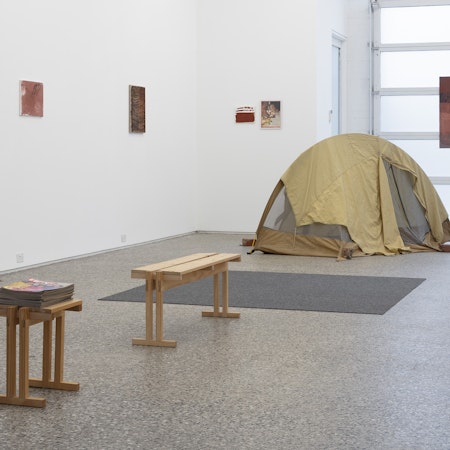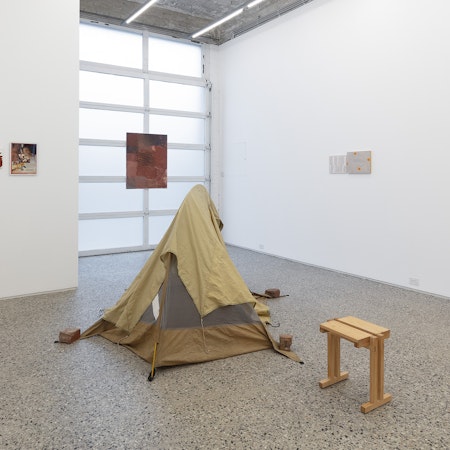'The body's sensation, its feeling, its touch, are with history.’ – Randy Martin¹
To be intimately acquainted with Arini Byng’s practice, is to know that it is through her work that she attempts to understand the world, her own experience, and the structures that shape both. Arini works across conventional mediums—photography, video, performance, painting and installation—but it could be argued that gesture is the primary medium uniting her artistic output. Gestures do not merely appear in Arini’s works, they shape them. Arini’s works are borne of the body and the quiet assertion that the personal is political.
Dancer and cultural theorist Randy Martin considered movement as being indexed by the socio-political and the psycho-emotional.² He saw dance as having, ‘a sentient apprehension of movement and a sense of possibility as to where motion can lead us, that amounts to a material amalgamation of thinking and doing as world-making activity’.³ Arini’s performance works—which often include a mix of trained and untrained dancerly, artistic and/or musical collaborators—reflect this in their examination of our corporeality. They use careful gestures to distill the ways in which one experiences the world through the body, and the inherent cultural significance of each material self. To date, her performance works have conceptually troubled the body’s encounter with specific spatial settings, personal and familial dynamics, and political and social issues.
Until 2023, Arini’s practice was underpinned by a collaboration with her father, Travis Byng, a Black American man born and raised in Philadelphia. Travis migrated to Australia in 1984 with Arini’s mother, Anna, and her sister Chren. Travis was Arini’s best friend and the bridge between her life here in colonial Australia and her Black American family and cultural history. Arini’s PHOTO 2022 exhibition Some voices carry at CAVES in Naarm Melbourne—in which she exhibited images from her family’s archive, framed or mounted on steel screens—provides a poignant example. The exhibition emphasised the role that photography plays in connecting diaspora artists like Arini, whose cultural identity is conflicted, to the familial and cultural history from which they’re removed.
Shortly before Arini entered the Gertrude Studio Program, Travis passed away suddenly, leaving Arini to grieve not only the loss of her parent and collaborator, but to come to terms with what it means to continue to make work engaging with her cultural heritage, without her primary link to it. The work that Arini has made during her studio tenure is marked by this grief. The paintings in How we breathe may be read as cathartic expressions of processing this profound loss. These paintings are laden with the gestures of Arini’s hand and mirror the state of flux she has been in, whilst grappling with how to work without her father.
In the other works in How we breathe, the artist can be seen emerging from this period of uncertainty and starting to carve out a new way of working. The photographic collage works in this exhibition continue the work begun in Some voices carry, but using a new methodology. They overlay images from her familial archive with pages taken from issues of EBONY magazine from the year 1980, when her parents met, and 1982 when they got married. Published by the now-defunct Black-owned Johnson Publishing Company, EBONY is described as a magazine, ‘by us, for us.’⁴ The periodical centres on issues of social justice, health and wellness, beauty, fashion, sports and education, spotlighting the experience and contribution of Black Americans.
Arini’s collages employ a similar approach to that used by Theaster Gates in the 2024-25 exhibition, When Clouds Roll Away: Reflection and Restoration from the Johnson Archive.⁵ Gates bound his personal collection of EBONY magazines in three pink leather editions and inserted blank pages at the centre to demarcate space and create room for future engagement.⁶ So too are Arini’s collages an incursion into archival material. Arini’s placement of private family photographs over pages from EBONY with corresponding headlines or content is an attempt to situate her familial narrative in the broader cultural experience of the time these photos and magazines were made. In this respect, this overlaying is a strategy to travel—emotionally and temporally—and connect with that which has been lost—a time, place and context she feels distanced from. Arini describes it as, ‘an attempt to deconstruct my (her) understanding of Blackness.’⁷
The performance How to Just Be, which opens and closes this exhibition, is a new iteration of a work commissioned for Performance Review’s 2025 Performing Care project. How to Just Be is both the first performance Arini has made without Travis and the first working with an all-Black ensemble. To make this work, Arini collaborated with performers Jacob Coppedge (Philadelphia, USA), Peta Duncan (Mer Island, Torres Strait), and Amaara Raheem (Colombo, Sri Lanka). These performers both assumed the role that Travis held in Arini’s work—as a sounding board and critical eye—and also brought their own lived experience into the work, in an attempt to answer the question, ‘What feels meaningful to express in a world shaped by absence?’ The question is both deeply personal in the context of Arini’s grief and universal in this present moment marked by mass loss, economic disparity, and social upheaval.
Through a series of choreographic workshops, Byng, Coppedge, Duncan and Raheem generated a co-authored score that explores the gaps between language and movement, relational dynamics and the ways that vulnerability physically manifests. In Performance as Political Act: The Embodied Self, Martin wrote, ‘the body as it is revealed through performance stands as a source of political activity. Like any agent of social change, it forges its own agenda and responds to a particular history. The body then cannot be reduced to a mere reflection of what it opposes.’⁸ How to Just Be is proof of this idea, that the performing body does not reflect the political, but rather is political. Through subtle, yet impactful gestures, this performance does not simply evoke a representation of tender kinship, but presents to us a collective. In this way, it evokes the quiet yet powerful activism implicit in coming together as a mode of resistance.
Marrying movement and dialogue, Coppedge, Duncan and Raheem move slowly through different choreographic sequences. They either move together or in a combination of solos and duos, and when they speak, they either break off alone or do so in chorus. Duncan and Raheem build a tent—purchased by Arini’s parents in 1981—while Coppedge watches on, dancing beside them. The performers oscillate around each other, resting their heads against one another’s shoulders and backs, pausing in different configurations. What unites this performance is a palpable sense of support and an acknowledgement of shared experience. Coppedge, Duncan and Raheem’s constant physical contact with themselves, each other, or props, tangibly affirms the care that exists between these three performers.
How to Just Be emphasises the necessity of a support network, as a salve against deeply uncomfortable and divided times, and as a paddle to wade through grief.
The three bodies of work in How we breathe, chart Arini’s journey over the last two years and the role that artistic practice has played. United by subtle gestures, Arini’s paintings see her moving through and coming to terms with loss; her photographic collages see her testing new approaches to broach subject matter she has felt blocked from working with since her father’s death; as does the performance How to Just Be, which sees her forming new relationships and seeking new modes of support to continue practicing in this medium. How we breathe is an exhibition about grief and becoming, about losing kin and finding others. Graceful and restrained, it is a show about strength and resilience.
1. Randy Martin, Performance as Political Act: The Embodied Self (Connetict: Praeger, 1990),
2. June Miskell, “the feeling that moves us,” Free
Association, 07.04.2021, https://
freeassociation.
com.au/?texts=the-feeling-that-moves-us.
3. André Lepecki, Of the Presence of the
Body: Essays on Dance and Performance
Theory (Connecticut, Wesleyan University
Press, 2004), 48.
4. “EBONY Magazine: Moving Black Forward,”
EBONY, viewed 1 May 2025, https://www
ebony.com/about-ebony/.
5. “Exhibitions:Theaster Gates When Clouds Roll
Away Reflection and Restoration from the
Johnson Archive,” Rebuild Foundation, viewed
1 May 2025, https://www.rebuild-foundation.
org/exhibitions.
6. “EBONY Books, a Theaster Gates Collection,”
The Conservation Centre, viewed 1 May 2025,
https://www.theconservationcenter.com/
articles/2016/9/14/ebony-books-a-theaster-
gates-collection.
7. Arini Byng, in conversation with Anador Walsh,
20 May 2025.
8. Martin, Performance as Political Act, 2.


